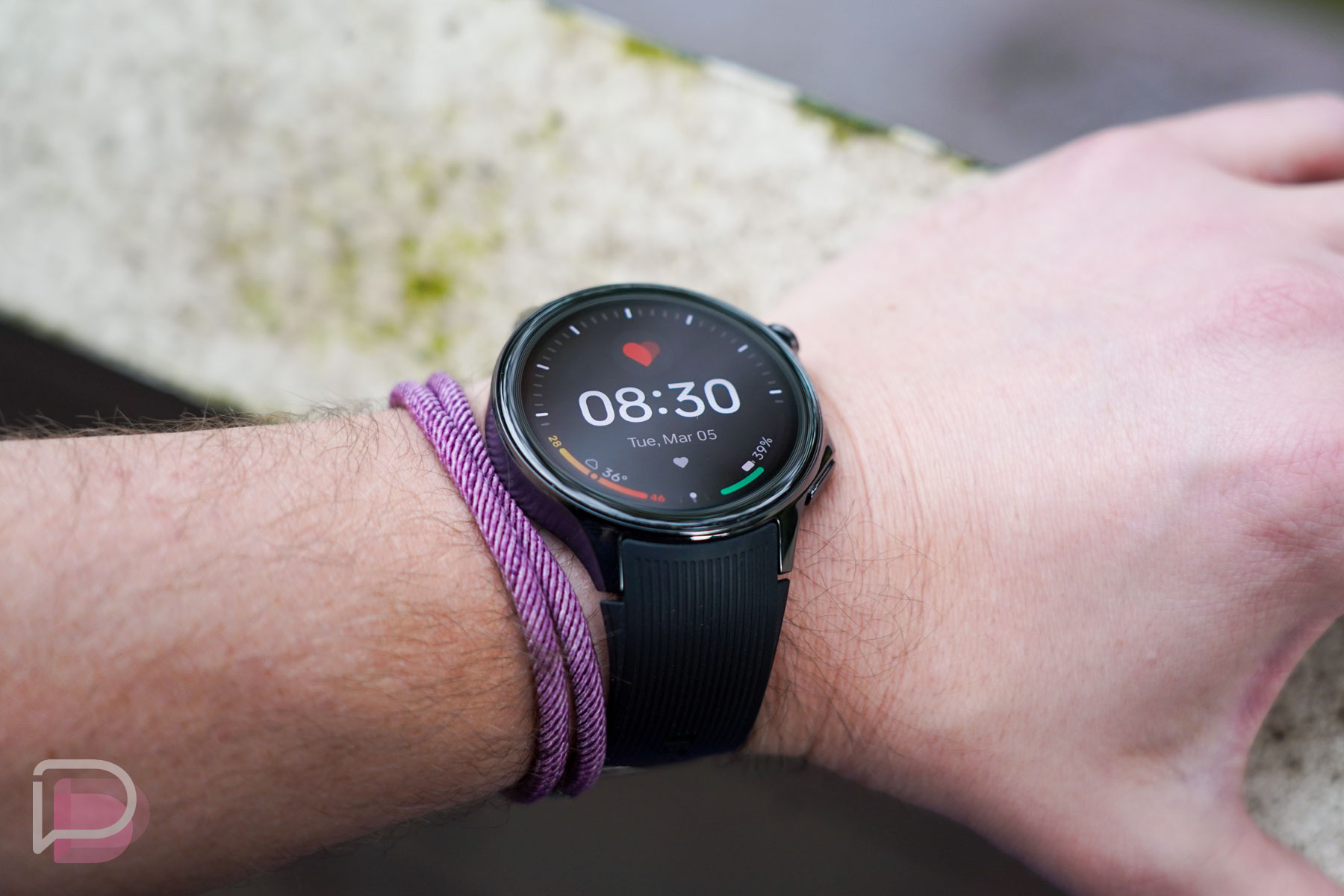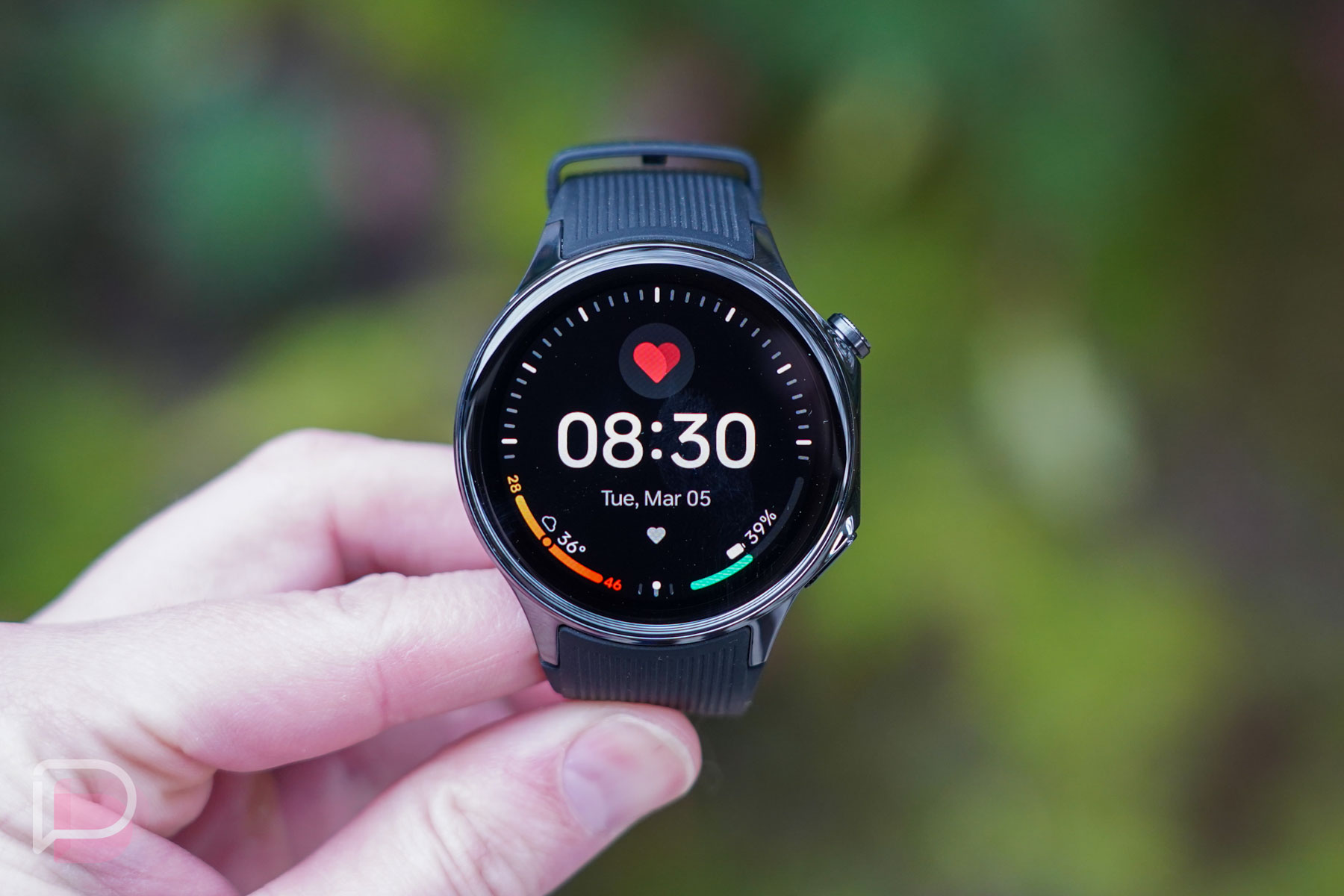The story of the original OnePlus Watch is not one to remember. OnePlus launched that device as some sort of fitness or wellness tracker, but it was bug-filled, weirdly sold, and didn’t run Wear OS. So to be honest, when we heard that OnePlus was considering a follow-up wearable, we weren’t exactly excited. As it turns out, they made a bunch of great decisions for the OnePlus Watch 2 and delivered something you’ll likely consider if you are in the market for a Wear OS device.
To recap, the OnePlus Watch 2 is a Wear OS-powered watch that also happens to run two different processors in tandem (Snapdragon W5 and a low-power MCU). Google helped tweak Wear OS for the OnePlus Watch 2 to allow both processors to seamlessly hand-off tasks between them and provide incredible battery life. OnePlus is promising at least 48 hours on a single charge with everything thrown at it, but you can extend that to 100 hours by running the watch in Smart Mode, which is what I did.
You’ll also find a stainless steel case in black or silver, a big 1.43″ round AMOLED display, sapphire crystal cover glass, 500mAh battery, 2GB RAM, 32GB storage, WiFi, Bluetooth 5.0, Dual Frequency GPS, NFC, 5ATM water resistance, and a heartrate sensor.
The OnePlus Watch 2 is a $299 watch, but you can save $50 on most days through a promotion that OnePlus is running where they’ll take almost any watch trade and give you that discount.
What’s good about the OnePlus Watch 2?
Battery life. I feel like I have to start here, because rarely does a company promise exceptional battery life and then actually deliver it. OnePlus has done it with the OnePlus Watch 2. The 500mAh battery is rated at up to 100 hours of usage in Smart Mode and I came close to it while testing.
For my very first charge, I put the OnePlus Watch 2 on the wrist on a Friday afternoon, left always-on display active, wore it to sleep every night, and got in two workouts. I didn’t need to charge until Monday morning. For the second charge, which I charged to full on that Monday morning, it lasted until Friday, though that was without any workouts. That’s wild!
And again, this is the work of Google and OnePlus allowing Wear OS to utilize a low-power processor for the majority of daily tasks (like notifications), while letting the big Snapdragon W5 handle anything more intense. The power sipping here is incredible. It just never felt like a watch that wasn’t going to keep going or make it until the next day or three.
I should also point out that the handoff of tasks between the two chipsets is done flawlessly. Never during testing did I run into a situation where I thought, “Man, I can tell the low-power chip is here slowly doing what I’d rather the other chip do.” Instead, everything just worked and you can’t tell which chip is doing which tasks, as should be the case.
In the charging department, this watch charges with an included PIN dock, so it’s not Qi. It’ll hit 100% charge from almost nothing in about 60 minutes. That’s a pretty normal charging time, but since you only need to do that every 3-4 days, I don’t think most people will mind.
Absolutely incredible stuff here from OnePlus in the battery department.
Design. Overall, I like the design of the OnePlus Watch 2. I like its weird side shelf with big pusher button up top and less-pronounced bottom button. There’s a distinct style here that isn’t just another copy of a Galaxy Watch. It’s certainly nothing like the Apple Watch or Pixel Watch either. I think OnePlus did a solid job of making a unique watch design that isn’t too unique.
The OnePlus Watch 2 is a big watch at around 47mm, yet with its subtle curves at the lugs, it wore pretty well on my wrist. It also looked slightly goofy with its overall size, but I didn’t necessarily notice tremendous weight or it getting in my way. Just prepare for a big watch if this is one you are considering.
For bands, it comes with a black rubber band on the black model or a greenish band on the silver model. This is a 22mm band that can be removed in favor of your own 22mm band. Overall, the band that comes with it is decent quality, but it is slightly thick and I found myself at times wishing for something lighter. The included band fits into the lugs like Samsung’s bands on the Galaxy Watch and that design choice isn’t my favorite. But again, I would just swap the band out going forward.
Health tracking. For me, owning a smartwatch is mostly about health and fitness tracking. Notifications drive me nuts and I turn most off, but I’m addicted to data about my heart, sleep, and overall fitness status. The OnePlus Watch 2 has a pretty big focus on wellness and does a good job of tracking most of it in their OHealth app.
If you happen to be a runner, OnePlus has built in several metrics that you wouldn’t typically find on a Wear OS watch. Obviously, it can track your heartrate all day and night and during workouts, your zones, pace, elevation, etc. It can also track cadence, as well as your ground contact time, vertical oscillation, and vertical ratio, running power, stride length, and energy recovery. It is quite advanced for a smartwatch that isn’t necessarily sold as a running watch like a Garmin. I’m quite impressed by all of the data it offered me when out for a run.
For other workouts and health stuff, it’ll keep track of your daily heart rate, sleep and its various stages, SpO2, stress levels, calories, steps, and more. Most of these categories can also show your daily, weekly, monthly, and yearly records over time, plus you can record workouts from within the app if you want.
This watch doesn’t do temperature tracking because it doesn’t have that type of sensor. It doesn’t do menstrual tracking or record ECGs either. Those could be dealbreakers for some. I’d imagine. They aren’t metrics I ever look to.
I was able to take the OnePlus Watch 2 out for a run and it tracked via GPS very accurately on a normal route of mine. I found the heartrate to be accurate or at least very inline with other devices I track these metrics with during intense workouts. Its sleep monitoring was where I hoped it would be and the OHealth app presented the data well. I have no complaints from the health tracking experience here, only that I wish it tracked heartrate variability (HRV). It’s odd that it doesn’t. (Update: OnePlus claims to record HRV and use it to create a stress score, but as far as I can tell, doesn’t tell you what your HRV is.)
Performance, display, software. All of these areas are excellent on the OnePlus Watch 2. It has a big beautiful display that I had no trouble seeing or interacting with when outside or indoors. Performance, as I sort of mentioned earlier, is very good even as tasks dance between two different chipsets. This watch is as smooth as a OnePlus phone, which is saying a lot.
As far as software goes, the Wear OS experience will be familiar to those who have used Wear OS before. OnePlus hasn’t done OxygenOS for watches or anything weird. It looks like Wear OS, acts like it, and you should have no trouble getting through notifications, firing up apps, or changing settings.
You do have to use the OHealth app to manage watch faces, notification settings, tiles, and that sort of thing. Sure, you could do a lot of that on-device, but that’s never fun on a smartwatch. The OHealth app at times was confusing to use because there are quite a few settings in there to further customize the Watch 2 experience, but you also don’t need to use it that often. It’s fine as a companion app – nothing special, not worth complaining about.
Is anything wrong with the OnePlus Watch 2?
This is a weird area for this watch to try and dive into because I don’t know that I would say anything really is “wrong” with it. Is it perfect? Well, no. I would point out that it is huge and for many, it will fit weirdly on the wrist, possibly looking goofy too. OnePlus wanted to cram a massive battery inside and two chipsets to create a watch that would last for most of a week and they did that, but that unfortunately means a device that isn’t going to fit everyone.
It’s missing some health features for women and for those who need regular ECG readings. It won’t work with an iPhone, so that’s a thing. It charges with PINs, doesn’t have cellular connectivity, and requires you to use OnePlus’ OHealth app for connectivity. The top right-side button looks like it could rotate for movement in the OS, but it doesn’t do that. It just spins and is something to fidget with.
Ummm, I think that’s mostly all I would complain about.
Should you buy a OnePlus Watch 2?
It’s good, that’s for sure. At $299, the price is probably correct with all that it offers, plus you should be able to get a discount on it going forward to make it more like $250.
After using the OnePlus Watch 2, I’d probably pick it over the Pixel Watch 2 just for the battery life alone. I prefer it’s fitness tracking too. If you are comparing to the bigger Galaxy Watch 6 models, that’s a tougher call, although it is quite a bit cheaper at $299 vs. $399 or $429.
Beyond the battery life and decent price, the OnePlus Watch 2 also stands out because of its stellar performance, the unique dual chipset setup that works so flawlessly, and the big display. This is a winner of a smartwatch.



Collapse Show Comments14 Comments